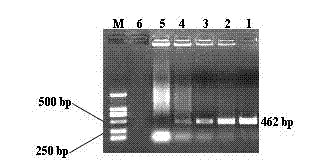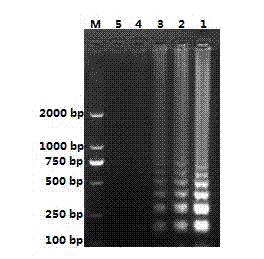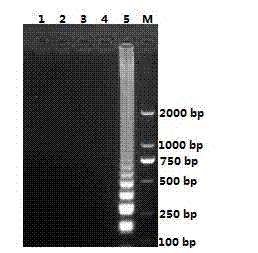Visualized loop-mediated isothermal amplification kit for detecting Haemophilus parasuis
A ring-mediated isotherm, Haemophilus suis technology, applied in the direction of microbe-based methods, microbiological measurement/testing, biochemical equipment and methods, etc., can solve problems such as limiting practical applications, achieve high specificity and simple operation Convenience and good sensitivity
- Summary
- Abstract
- Description
- Claims
- Application Information
AI Technical Summary
Problems solved by technology
Method used
Image
Examples
Embodiment 1
[0055] Preparation of Visualized Loop-Mediated Isothermal Amplification Kit for Detection of Haemophilus parasuis
[0056] 1. Synthesis of Primers
[0057] Artificially synthesize the following 3 pairs of primers:
[0058]
[0059] 2. Preparation of loop-mediated isothermal amplification reaction solution
[0060] Each 23 μL ring-mediated isothermal amplification reaction solution contains the following components: Tris-HCl (1.0 mol / L) 0.5 μL, KCl (0.5 mol / L) 0.5 μL, (NH 4 ) 2 SO 4 (0.5 mol / L) 0.5 μL, MgSO 4 (20 mmol / L) 5 μL, 0.1% Triton X-100, betaine (18 mmol / L) 3 μL, dNTP (2.5 mmol / L) 2.5 μL, Bst DNA large fragment polymerase (8U / μL) 1 μL , FIP and BIP (25 μmol / L) each 1.6 μL, F3 and B3 (25 μmol / L) each 0.4 μL, LF and LB (25 μmol / L) each 0.8 μL.
[0061] 3. Assembly of the Kit
[0062] The kit consists of the following materials: the ring-mediated isothermal amplification reaction solution prepared in step 2, Haemophilus parasuis DNA (positive control) (preserved ...
Embodiment 2
[0064] PCR sensitivity test of palA gene:
[0065] The prepared Haemophilus parasuis genomic DNA was diluted in 10-fold increments, and the DNA concentration of each gradient after dilution was measured with a protein and nucleic acid quantifier, which were 4ng, 0.4ng, 40pg, 4pg, and 0.4pg, respectively. The DNA of each concentration was amplified by PCR using the established PCR method for detecting palA. 1% agarose gel electrophoresis analysis. The sensitivity test results of PCR were as follows: figure 1 As shown, it shows that the PCR method has a minimum detection limit of 4pg of Haemophilus parasuis genomic DNA.
[0066] Sensitivity test of the kit:
[0067] Use Haemophilus parasuis genomic DNA at a concentration of 4pg, 0.4pg, 0.04pg, 4fg, and 0.4fg as the template DNA to be tested; add 23 μL of the loop-mediated isothermal amplification reaction solution into the reaction tube, and 2 μL Mix the template DNA; place the reaction tube in a water bath at 55°C for 30 mi...
Embodiment 3
[0069] Specificity test of the kit:
[0070] Use the genomic DNA of Haemophilus parasuis, Pasteurella multocida, Actinobacillus pleuropneumoniae, and Streptococcus suis as the template DNA to be tested; add the ring-mediated isothermal amplification reaction solution 23 into the reaction tube μL, 2 μL template DNA, mix well; place the reaction tube in a water bath at 55°C for 40 min; react in a water bath at 80°C for another 5 minutes; analyze the results by 2% agarose gel electrophoresis. The result is as image 3 As shown, only the genomic DNA samples of Haemophilus parasuis were positive, while the genomic DNAs of Pasteurella multocida, Actinobacillus pleuropneumoniae, and Streptococcus suis had no characteristic ladder-shaped bands.
PUM
 Login to View More
Login to View More Abstract
Description
Claims
Application Information
 Login to View More
Login to View More - R&D
- Intellectual Property
- Life Sciences
- Materials
- Tech Scout
- Unparalleled Data Quality
- Higher Quality Content
- 60% Fewer Hallucinations
Browse by: Latest US Patents, China's latest patents, Technical Efficacy Thesaurus, Application Domain, Technology Topic, Popular Technical Reports.
© 2025 PatSnap. All rights reserved.Legal|Privacy policy|Modern Slavery Act Transparency Statement|Sitemap|About US| Contact US: help@patsnap.com



